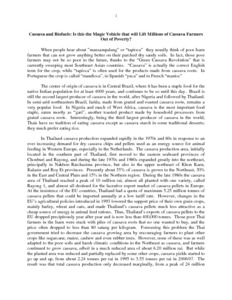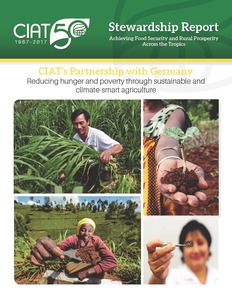agricultor
AGROVOC URI:
Cassava and biofuels: is this the magic vehicle that will lift millions of cassava farmers out of poverty?
Cattle breed preferences and breeding practices in southern Nigeria
Reports on completed and planned research to examine farmers' perceptions of different breeds, the discretion they exercise over breed composition, and the impacts of breed perceptions on breeding practices. ILCA has recently undertaken three household surveys that shed light on farmers' breed preferences and breeding practices. The survey results indicate that farmers' breed prortfolios are the outcome of dynamic processes that vary across farmers and environmental conditions.
Characteristics of urban and peri-urban agriculture in West Africa: results of an exploratory survey conducted in Tamale (Ghana) and Ouagadougou (Burkina Faso)
The report summarizes key results from surveys carried out on urban and peri-urban agriculture (UPA) in Tamale (Ghana) and Ouagadougou (Burkina Faso) in 2013. The aim was to provide a broad overview of the state of UPA in the study cities and a basis for future research endeavors. The randomized sampling approach used aerial photography to identify 10 sites in different categories of farm in each city. Farmers provided information on their cropping and livestock-rearing activities.
Characterization of Historical Seasonal and Annual Rainfall and Temperature Trends in Selected Climatological Homogenous Rainfall Zones of Uganda
There is general lack of scientific consensus on the trend and distribution of annual and
seasonal rainfall and temperature in Uganda. This study used both observational and AgMerra
rainfall and temperature data for the period 1980-2010 to characterize the trend and variability in
seasonal and annual rainfall, maximum and minimum temperatures across 12 different rainfall
homogenous zones (K, H, ME, L, J, F, MW, D, E, A1, A2, and I) of Uganda. Trends analysis was
done using regression method, while coefficient of variation and ANOVA techniques were used
CIAT Hillsides Program Annual report draft part 1-1995
CIAT in Kenya: Science for Impact
The International Center for Tropical Agriculture (CIAT), in collaboration with our national research partners, has been working in Kenya for the last 30 years. Our cutting-edge science helps policy makers, private sector, scientists, civil society, and farmers respond to the most pressing challenges of our time.
CIAT’s Partnership with Germany: Reducing hunger and poverty through sustainable and climate-smart agriculture
Climate change and gender: what role for agricultural research among smallholder farmers in Africa?
This study was commissioned to provide an understanding of the complex impacts climate change will likely have on existing gender and social inequalities.
Comparative analysis of morphological and farmers' cognitive diversity in yams landraces (Dioscorea spp.) from southern Ethiopia
Neglected by research and development, knowledge of the genetic diversity in Ethiopian yams is found mainly with the local farmers. The local yam classification system in Southern Ethiopia was studied through individual and key informant interviews. Data collected include attributes/traits of each landrace used in the folk taxonomy. Local farmers recognize two major categories of yams: ‘hatuma boye’ (‘male’ yam) and ‘macha boye’ (‘female’ yam). This categorization has no reference to the reproductive biology of the plant.
Competitive farming strategies and their effect on water provision and profitability among smallholder farms: the case of Muooni Dam site, Kenya
Dampak krisis ekonomi Indonesia terhadap petani kecil dan tutupan hutan alam di luar Jawa
Twenty million people live in or near Indonesia' s natural forests. The country's humid tropical forests are primarily in Sumatra, Kalimantan, Sulawesi, and Irian Jaya. A devastating regional economic crisis that began in mid-1997 affected Indonesia more strongly than any other country in Asia. A random sample survey of 1050 households was conducted in six outer island provinces to understand the effects of the crisis on the well-being of forest villagers and on their agricultural and forest clearing practices.






